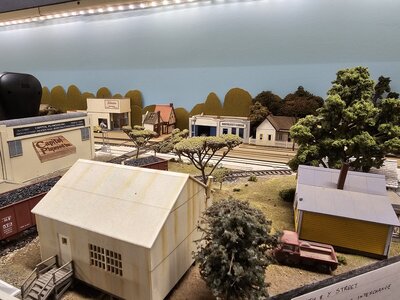Current dimensions are 9'6"x23', previously 11'x25' before relocation to its current home, with room to add a 5'5"x10' future branch line. Here's what the main layout looks like--9'6"x12' in its current form. Peco Code 100 Setrack with some Streamline switches. Minimum radius 15" mainline, 12" industrial spur, setting 1940-50 northern California interurban/industrial switching. Sectional construction has let me move the layout twice & grow sections as I had time & energy to do so. I run Digitrax DCC with manually operated turnouts. Operation is nominally by "wheel report" system, sometimes combined with switch lists, but often reverting to "let's move this boxcar over there and that tank car over here" ad-hoc switching. Passenger operation is occasional as this was principally an industrial belt line, but frequently chartered for fan trips by trolley jollies taking in the last days of electric railroading in Sacramento.
View attachment 181065
This view of the layout shows the original L-shaped mini layout, behind it is Haggin Yard, my main division point yard; a pair of sections measuring 12"x10' (formerly 12"x12' but had to cut down 2' to fit into current layout room), capacity about 40 cars. Once the around-the-room loop is complete, Haggin Yard will serve as both northbound and southbound division point yard, depending on which way the train is facing, but theoretically there are no through trains; all arrivals from north (Chico) or south (Oakland) are broken up upon arrival on either end of the Belt Line, which is all considered yard limits, and carried from one end to the other (or various interchanges) by local switching turns.
View attachment 181068
X Street is the middle of the layout, combining a large passing track (capacity about 10-12 cars, enough to hold the longest trains I'd regularly run), two interchanges, team track and 2 industries, and a connecting partial wye where the "branch line" (actually a separate railroad that shared the belt line, Central California Traction) diverges from the belt line. By the 1940s, the belt line, built around the perimeter of the city, was a densely populated residential neighborhood and tracks ran down the middle of the street.
View attachment 181071
Front Street is a waterfront dock and industrial area along the Sacramento River; this small freight depot and yard at 2nd & M Street is another Inglenook-behind-a-passing-track combination, complicated by a 4% grade from the river levee to Sacramento's original street level (the city's downtown streets & buildings were raised an entire story to limit the effects of floods, but the alleys dip down to the old grade.)
View attachment 181072
West Sacramento/Westgate Yard section is currently under construction, it will be the largest single section at 8'x3' at its full extent, but can be broken down into 2 sections so if I have to move it again I can fit each section in the 6'x3' bed of my station wagon. It's a combination of industrial area, small supplemental yard for northbound trains, with a wye for reversing equipment that models the wye that led to Sacramento Northern's Woodland Branch (obviously some benchwork's going to go here). The curve to the right will connect to a bridge across the main garage entrance (removable) and a section that will feature a bridge over the American River (not removable) that connects to Haggin Yard, forming a loop.
View attachment 181069



